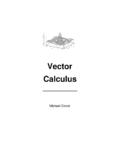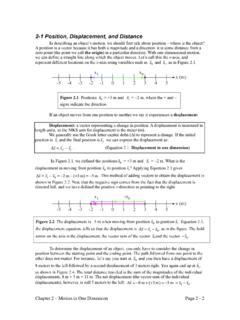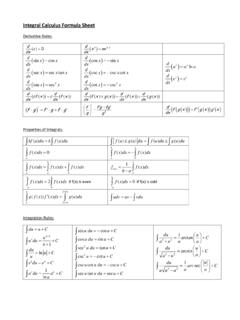Transcription of Vector Calculus
1 1. z 0. -10. -5. -10 0 x -5. 0 5. y 5 10. 10. Vector Calculus Michael Corral Vector Calculus Michael Corral Schoolcraft College About the author: Michael Corral is an Adjunct Faculty member of the Department of Mathematics at Schoolcraft College. He received a in Mathematics from the University of California at Berkeley, and received an in Mathematics and an in Industrial & Operations Engineering from the University of Michigan. This text was typeset in LATEX 2 with the KOMA-Script bundle, using the GNU Emacs text editor on a Fedora Linux system.
2 The graphics were created using MetaPost, PGF, and Gnuplot. Copyright 2008 Michael Corral. Permission is granted to copy, distribute and/or modify this document under the terms of the GNU Free Documentation License, Version or any later version published by the Free Software Foundation; with no Invariant Sections, no Front-Cover Texts, and no Back-Cover Texts. A copy of the license is included in the section entitled GNU Free Documentation License . Preface This book covers Calculus in two and three variables.
3 It is suitable for a one-semester course, normally known as Vector Calculus , Multivariable Calculus , or simply Calculus III . The prerequisites are the standard courses in single-variable Calculus ( Calculus I and II). I have tried to be somewhat rigorous about proving results. But while it is important for students to see full-blown proofs - since that is how mathematics works - too much rigor and emphasis on proofs can impede the flow of learning for the vast majority of the audience at this level.
4 If I were to rate the level of rigor in the book on a scale of 1 to 10, with 1 being completely informal and 10 being completely rigorous, I would rate it as a 5. There are 420 exercises throughout the text, which in my experience are more than enough for a semester course in this subject. There are exercises at the end of each sec- tion, divided into three categories: A, B and C. The A exercises are mostly of a routine computational nature, the B exercises are slightly more involved, and the C exercises usu- ally require some effort or insight to solve.
5 A crude way of describing A, B and C would be Easy , Moderate and Challenging , respectively. However, many of the B exercises are easy and not all the C exercises are difficult. There are a few exercises that require the student to write his or her own computer pro- gram to solve some numerical approximation problems ( the Monte Carlo method for approximating multiple integrals, in Section ). The code samples in the text are in the Java programming language, hopefully with enough comments so that the reader can figure out what is being done even without knowing Java.
6 Those exercises do not mandate the use of Java, so students are free to implement the solutions using the language of their choice. While it would have been simple to use a scripting language like Python, and perhaps even easier with a functional programming language (such as Haskell or Scheme), Java was cho- sen due to its ubiquity, relatively clear syntax, and easy availability for multiple platforms. Answers and hints to most odd-numbered and some even-numbered exercises are pro- vided in Appendix A.
7 Appendix B contains a proof of the right-hand rule for the cross prod- uct, which seems to have virtually disappeared from Calculus texts over the last few decades. Appendix C contains a brief tutorial on Gnuplot for graphing functions of two variables. This book is released under the GNU Free Documentation License (GFDL), which allows others to not only copy and distribute the book but also to modify it. For more details, see the included copy of the GFDL. So that there is no ambiguity on this matter, anyone can make as many copies of this book as desired and distribute it as desired, without needing my permission.
8 The PDF version will always be freely available to the public at no cost (go to ). Feel free to contact me at for iii iv Preface any questions on this or any other matter involving the book ( comments, suggestions, corrections, etc). I welcome your input. Finally, I would like to thank my students in Math 240 for being the guinea pigs for the initial draft of this book, and for finding the numerous errors and typos it contained. January 2008 M ICHAEL C ORRAL. Contents Preface iii 1 Vectors in Euclidean Space 1.
9 Introduction .. 1. Vector Algebra .. 9. Dot Product .. 15. Cross Product .. 20. Lines and Planes .. 31. Surfaces .. 40. Curvilinear Coordinates .. 47. Vector -Valued Functions .. 51. Arc Length .. 59. 2 Functions of Several Variables 65. Functions of Two or Three Variables .. 65. Partial Derivatives .. 71. Tangent Plane to a Surface .. 75. Directional Derivatives and the Gradient .. 78. Maxima and Minima .. 83. Unconstrained Optimization: Numerical Methods .. 89. Constrained Optimization: Lagrange Multipliers.
10 96. 3 Multiple Integrals 101. Double Integrals .. 101. Double Integrals Over a General Region .. 105. Triple Integrals .. 110. Numerical Approximation of Multiple Integrals .. 113. Change of Variables in Multiple Integrals .. 117. Application: Center of Mass .. 124. Application: Probability and Expected Value .. 128. 4 Line and Surface Integrals 135. Line Integrals .. 135. Properties of Line Integrals .. 143. Green's Theorem .. 150. v vi Contents Surface Integrals and the Divergence Theorem .. 156.



